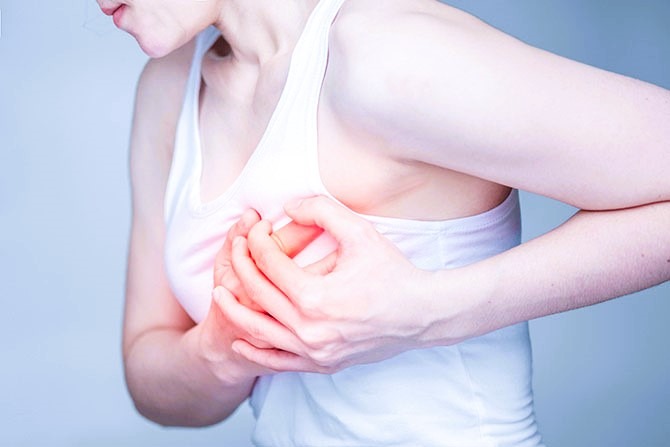Mastalgia (Breast Pain): Causes, Symptoms & Effective Treatments
Mastalgia, or breast pain, affects many women. Learn about its types, causes, symptoms, and effective treatment options to manage this common condition, and more.


What is Mastalgia (Breast Pain)?
Mastalgia, commonly known as breast pain, is a frequent concern among women and can occur at any stage of life. This discomfort may range from mild sensitivity to intense pain and can significantly affect a woman’s quality of life, including daily activities and emotional well-being.
There are two primary types of mastalgia:
Cyclical Mastalgia: Linked to hormonal changes during the menstrual cycle, this type is most common among women of reproductive age. It often presents as a dull ache or breast tenderness that worsens before menstruation and improves afterward. The predictable nature of cyclical mastalgia makes it easier to identify and manage.
Non-Cyclical Mastalgia: This form of breast pain is unrelated to the menstrual cycle and can result from injury, infection, medication side effects, or underlying medical conditions. Non-cyclical mastalgia is more sporadic and may affect one breast more than the other.
Studies reveal that 50% to 70% of women experience breast pain at some point. While mastalgia is often benign, persistent or unusual pain should not be ignored, as it may be a symptom of more serious issues like breast cysts, mastitis, or breast cancer. According to the American Cancer Society breast pain alone is rarely a sign of cancer, but it should always be evaluated if accompanied by other symptoms like lumps, nipple discharge, or skin changes.
Consulting a healthcare provider for persistent symptoms is essential for early diagnosis and peace of mind.
Common Causes of Mastalgia
1. Cyclical Causes
Cyclical breast pain is most commonly associated with:
Menstrual cycle: Hormonal fluctuations, especially increased estrogen and progesterone during the luteal phase, cause breast tissue swelling and tenderness.
Pregnancy: Elevated hormone levels prepare the breasts for lactation, often resulting in sensitivity and discomfort.
Menopause: Hormonal imbalances during the transition to menopause can also contribute to breast pain.
2. Non-Cyclical Causes
Non-cyclical mastalgia can stem from:
Injury or trauma: Physical blows or surgical procedures on the breast can result in localized pain.
Medication side effects: Hormone-based drugs (e.g., birth control pills, hormone replacement therapy), and even some antidepressants, can trigger mastalgia.
Lifestyle factors: Excessive caffeine intake, poor diet, smoking, and stress may worsen symptoms.
Breast infections (mastitis): Common in breastfeeding women, this infection causes painful swelling and redness.
Benign or malignant growths: Cysts, fibroadenomas, or tumors may cause localized breast pain and should be evaluated promptly.
According to the Mayo Clinic both hormonal imbalance and lifestyle habits can significantly influence non-cyclical breast pain.
Understanding the root cause is essential to manage the condition effectively and avoid unnecessary stress.
Symptoms of Mastalgia
Mastalgia may vary widely between individuals. Common symptoms include:
Sharp, throbbing, or burning pain
Breast tenderness or swelling
Pain that increases before menstruation and decreases after
Discomfort during physical activity or when wearing a bra
Pain may affect one or both breasts and can radiate to the underarm or upper chest. It’s crucial to monitor changes in breast size, shape, or skin texture and report any persistent or unusual symptoms to your doctor.
Emotional effects such as anxiety or sleep disturbances are also common and deserve equal attention.
Treatment & Management of Mastalgia
1. Lifestyle Changes
Dietary Adjustments: A low-fat, high-fiber diet rich in omega-3 fatty acids, fruits, vegetables, and whole grains may help reduce inflammation.
Limit caffeine and salt: Reducing intake can ease fluid retention and breast swelling.
Stay hydrated: Proper hydration supports overall breast tissue health.
Supportive bras: Wearing a well-fitted sports bra can reduce discomfort during movement.
2. Physical Activity & Stress Management
Engage in regular exercise such as walking, yoga, or swimming to maintain hormone balance.
Practice stress-relief techniques like meditation, deep breathing, or mindfulness to manage emotional triggers.
3. Medical Treatment
OTC Pain Relievers: Medications like ibuprofen or acetaminophen can help reduce pain and inflammation.
Hormonal Therapy: Birth control pills or hormone-regulating medications may be prescribed for cyclical mastalgia.
Topical NSAIDs: Gels or creams applied directly to the painful area may offer targeted relief.
4. Advanced Options
In rare cases where pain is persistent and linked to structural changes like fibrocystic breast disease, surgical intervention may be considered. However, this is typically a last resort.
Consulting with a healthcare professional is vital to develop a personalized treatment plan that addresses both physical and emotional symptoms.
Final Thoughts
Mastalgia is a common but often manageable condition. While most cases are not serious, consistent pain or unusual symptoms should not be overlooked. With the right combination of lifestyle adjustments, medical guidance, and self-care, women can effectively manage breast pain and protect their long-term breast health.
🙋♀️ Frequently Asked Questions (FAQs) About Mastalgia
Q1: Is mastalgia a sign of breast cancer?
A: Breast pain alone is rarely a sign of cancer. However, if the pain is persistent and accompanied by a lump, nipple discharge, or skin changes, consult a doctor.
Q2: How long does breast pain usually last?
A: Cyclical mastalgia often resolves after menstruation, while non-cyclical pain may persist until the underlying cause is treated.
Q3: Can diet affect mastalgia?
A: Yes, reducing caffeine, increasing fiber, and maintaining a balanced diet may help alleviate symptoms of breast pain.
Q4: When should I see a doctor for breast pain?
A: If the pain is severe, localized, lasts more than two weeks, or is associated with other unusual symptoms, it’s best to seek medical advice.
Q5: Can stress cause breast pain?
A: Yes, emotional stress can exacerbate hormonal imbalances, which may trigger or worsen mastalgia symptoms.
